Myths of nuclear energy
Questions we need to answer before deciding
by Miroslav Gregorič
Translation of an article by Miroslav Gregoric, Member of Slovenian National Assembly 🇸🇮 entitled “Myths of nuclear energy” ☢️ published in Saturday supplement of newspaper 📰 DELO on 📆25 January 2025.
With the fifth revision of the National Energy and Climate Plan [1] (NECP) and after the failed attempt for a quick referendum and the failed decision to build the second (and third) unit of the NPP, the professional public and all taxpayers should ask themselves whether we have enough data for a competent and informed decision-making.
It would not be good for the public to fall into the trap of half-truths, or even lies, as was the case with the thermal power plant – TEŠ6 project and the Velenje Coal Mine. It would also not be a good idea to witness the increase of the investment during construction by the Pi factor.
In this article, I would like to shed some light on some myths of nuclear energy.
Myth 1. More energy means more GDP.
For a long time, it was believed that the higher the consumption of (electricity) energy in a country, the higher the standard of living of the people, the more developed the industry is and the higher is the GDP. Our planet, shared by more than eight billion people, has the ultimate natural capacities and capacities that humanity has greatly challenged over the past two hundred years. One of these challenges is greenhouse gas emissions which is the result of the increase in fossil fuel consumption [2] by thirty-three over the past 220 years (world primary energy consumption rose from 5600 TWh in 1800 to 183 thousand TWh in 2023 (Figure 1), which has enabled today’s level of civilization, with an annual production of 2 billion tons of crude iron [3] (Figure 2), 4 billion tons of cement [4] (Figure 3), 200 million tons of fertilizers[5] (Figure 4), 413 million tons of plastics [6] (Figure 5), and other metals and minerals. We can ask ourselves whether this is sustainable and whether the trends are sustainable? The answer is clear – it’s not sustainable!
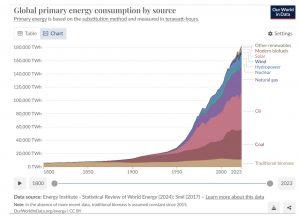
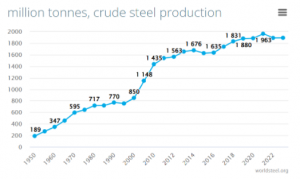
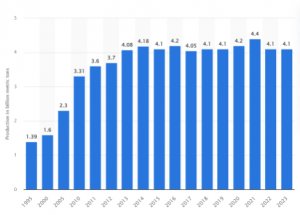
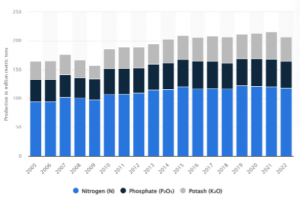
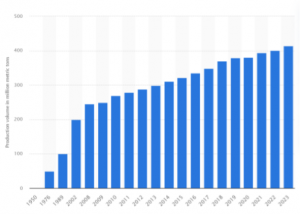
Some, especially western countries, have achieved extremely high energy consumption which can in no way be sustainable at the global level: for example 227 MWh/capita/year of primary energy in Kuwait [7], or 167 MWh/capita/year in Iceland or 101 MWh/capita/year in Norway. On the other hand, some countries have remained in the worst energy poverty: such as 0.217 MWh/capita/year in Somalia or 0.286 MWh/capita/year in the Central African Republic. (Figure 6)
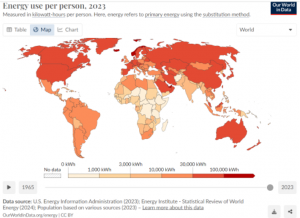
If we look at the density of nuclear power plants, mostly built in the 70s and 80s of the last century, we see that there was the highest density in Sweden, there were 12 nuclear reactors for a population of 8 million. In the United States [8], 112 power plants were built, when they had a population of 225 million, or 1 nuclear reactor per 2 million inhabitants, the same in Slovenia. In France [9], 56 reactors have been built for a population of 56million.
If we take the French density, that is one reactor per one million inhabitants and extrapolate this to India, we should have 1500 nuclear power plants in India today for a billion and a half inhabitants. China would need1400 reactors,Indonesia 300, Brazil 250 reactors, Africa 1800 reactors, and the world 8200 reactors. For such a scale of nuclear energy, we have neither the money, nor the people to build and operate them safely, nor the uranium nor the steel. We quickly realize that a Western European or American (energy) standard will be very difficult to enforce worldwide because it is unsustainable. Does this mean that poor countries will continue to be poor and have low GDP? Does this mean that developed countries need to do much more to make significantly more efficient use of energy and reduce consumption?
Worldwide, there are nuclear power plants in 33 countries[10] and there are no nuclear power plants in 160 countries.
If Slovenia starts building one new nuclear power plant today, it is as if the United States, according to the number of inhabitants, started building 165 units, France 35 or China 700. We may wonder why they don’t.
Myth 2. “According to COP-28, we will triple the share of nuclear energy by 2050.”
This was pledged, on December 1, 2023, in the framework of COP-28, by representatives of 25 countries, led by the United States, in the Declaration on the Tripling of Nuclear Power [11]. In doing so, they followed the results of the 2022 OECD NEA analysis [12] that limiting atmospheric warming to 1.5°C would require tripling nuclear power from the current 370 GWe to 1160 GWe by 2050. Slovenia is one of the signatories of the declaration. But the countries that build or supply by far the most new nuclear power plants are missing: China, Russia and India.
Europe is very unlikely to triple its nuclear energy by 2050. There are currently 100 reactors in operation in Europe, the vast majority of which are old and 90 of them will be shut down by 2050. So we will need 90 new reactors just to keep nuclear energy at its current level. A threefold increase in Europe alone would mean a total of 300 new reactors or the connection of 15 new large reactors in Europe each year from 2030 to 2050, which would require a total of 300 reactor vessels of 300 tons, 900 to 1200 steam generators of 400 tons and 900 to 1200 primary pumps of 100 tons, 600 transformers of 300 tons each, 300 turbines and electric generators of 1000 MW and more and 1200 large diesel generators… There are no such supply chains in Europe and the West. The investments, however, would amount to 4500 billion Euro plus interests costs, which for 30-year loans are comparable to the initial investment – so a total of about 9000 billion Euro investments. And that’s only in Europe.
Let’s look at the situation in the world. In 2004, electricity produced by nuclear power plants [13] accounted for 16% of all electricity generated in the world and today [14] only 9%. After the Three Mile Island accident in 1979, 52 preordered nuclear power plants were canceled in the United States [15], and those that were at a higher stage of construction mostly continued to be build. The golden age of nuclear power plant construction was in 1982 and 1983, when 32 reactors per year were connected to the grid around the world. In recent years, the total number of nuclear reactors in power plants in the world has hovered around 410. In 2023 five reactors were connected and five were turned off [16], and in the last ten years (2014 to 2023), 66 reactors were connected to the electric grid in the world, and 63 reactors were turned off. At this rate, it would take 300 years to triple the number of nuclear reactors in the world from 410 today to 1230.
IAEA PRIS data [17] show a harsh reality: that the increase of power of all nuclear power plants in the world over the past twenty years, from 2004 to 2023, has been a total of 7 GW (Figure 7). Over the same period, the capacity of solar power plants in the world grew by 1643 GW, from 3 GW to 1650 GW (Figure 8).
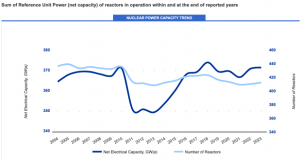
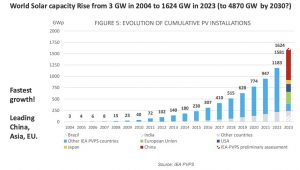
OECD NEA study “Achieving Climate Change Goals: The Role of Nuclear Power” [19] from 2022 and the “NEA Small Modular Reactors Dashboard – Second Edition” [20] from 2024 predict a different distribution of nuclear capacity in the world in 2050: existing nuclear power plants would retain 370 GWe (extending at least half of them to 80 years???), new large nuclear power plants would yield 300 GWe, and new small modular reactors- SMRs would yield 375 GWe (Figure 9). This last figure is at the level of science fiction, as it would require the construction and operation of 3,000 small modular reactors of 125 MWe or 4,870 NuScale US600 [21] small modular reactors of 77 MWe each (which already has an approved safety report from the US Nuclear Regulatory Commission) by 2050. It seems that paper and studies endure a lot.
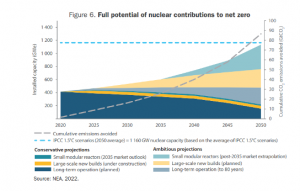
Myth 3. “Uranium is plentiful.”
In recent years, 50 to 60 thousand tons of natural uranium – yellow cake [22] – have been yearly extracted in the world, by far the most in Kazakhstan, followed by Canada, Namibia, Australia, Uzbekistan, Russia, Niger, China, India and South Africa. According to the recently published IRENA (International Renewable Energy Agency) report “Geopolitics of Energy Transition – Energy Security” [23] , the share of newly acquired uranium in the world by country is as follows (Figure 10):

There is no longer an operating uranium mine in Europe. From 50 to 60 thousand tons of yellow cake, 5 to 6 thousand tons of enriched uranium to 3 to 5% in U-235 is produced, which is needed to power existing nuclear power plants. TENEX from Russia has by far the largest uranium enrichment capacity, followed by Urenco in Germany, the Netherlands and the United-Kingdom, then Orano (ex-Areva) in France and the USA, and CNNC in China (Figure11). Argentina, Brazil, India, Pakistan and Iran also have commercially uninteresting capacities.
In addition to the declared threefold increase in nuclear power by 2050 with 1200 operating reactors, uranium uranium mining – yellow cake production – should also be tripled, the capacity for conversion from yellow cake U3O8 to uranium hexafluoride UF6 should be tripled, the fuel enrichment capacity should be tripled and the capacity for the conversion of UF6 to UO2 should be tripled, the production of zirconium and zirconium tubes should be tripled, and fuel production would have to be tripled. There is an unanswered question of how much, when, by whom, and where will invest in these new facilities.
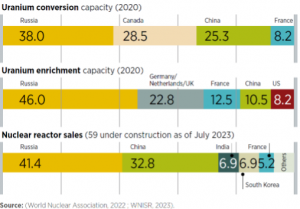
Myth 4. “Supply chains can be quickly restored for the goals of tripling nuclear power by 2050.“
Functioning supply chains have been maintained or created mainly in Russia, China, South Korea and partly Japan.
But what about when, in the current geopolitical reality, it is not appropriate to import from a non-democratic or authoritarian environment. The IRENA report gives country-by-country shares in the world for uranium conversion capacities (from yellow cake U3O8 to uranium hexafluoride UF6), for uranium enrichment, and for nuclear reactor sales. Currently, the share of the Western world is very weak (Figure 11). In the US, France, Canada, Germany, Japan, Spain, Italy, the Czech Republic, Ukraine, nuclear supply chains have largely stalled or were abandoned in the last 30 years, both in personnel, technological and industrial terms. New supply chains cannot be established quickly, as they require a lot of coordination, multidisciplinary staff, education for science, technology, engineering and mathematics (STEM), applied research, achieving high industry standards, the strictest quality assurance with traceability of all materials, processes and equipment, finances, the interest of industry – including heavy steel, long-term contracts, state incentives and the like, and above all, it is a long-term activity.
We cannot count on the established supply chains of the 70s and 80s of the last century, because they are no longer there. Unfortunately, the supply chains that have been used or are being used in the construction of the last power plants in Finland, France, the USA and the United Kingdom have not performed well. Above all, there is a problem with the high-quality production of large components such as reactor vessels, steam generators, main coolant pumps… The statements of the Chamber of Commerce and Industry of Slovenia that the Slovenian industry could supply 40% of the equipment for NEK-2 have no real basis and I prefer not to comment on them.
Myth 5. “The taxonomy [24] classifies nuclear energy as an environmentally sustainable resource—a low-carbon resource.”
The taxonomy sets the conditions for both gas-fired and nuclear power plants. In addition to the requirements for nuclear safety in accordance with the European Directives for Nuclear Safety and for the Safe Management of Radioactive Waste and Spent Fuel, and the requirements to establish a fund for the management of radioactive waste and spent nuclear fuel and a fund for the decommissioning of nuclear power plants, the taxonomy requires that a country that classifies nuclear energy as an environmentally sustainable source has, inter alia, an already operational repository for low- and intermediate-level waste (LILW) and a functioning repository by 2050 for high-level waste and spent nuclear fuel [25]. We do not yet have a repository for LILW, but we are already building the first silo, and we will finally build it within three years and dispose of the Slovenian half of the LILW in it. In the meantime, Croatia will find its way around. But in the meantime, and until then, half of Croatia’s waste will be with us on the NPP site. We have a fund for the decommissioning of the NPP, but we collect significantly too little funds in it, and certainly not for the disposal of the spent nuclear fuel.
Myth 6. “We’re going to build the nuclear power plant in 6 to 8 years.”
Yes, indeed, in the past, some nuclear power plants were built in six years, or even faster, if there were several reactors on the same site and they were built one after the other. Even today, China and Russia have been building nuclear power plants for about six years. But unfortunately, this does not happen in the West. The EPR reactor of the French company Areva in Finland, Olkiluoto 3, has been under construction for 18 years [26], the same reactor at Flamanville in France has been under construction for 17 years [27] and was only put into trial operation at the end of last year. For the AP 1100 plant in Vogtle USA, a contract was signed in 2008 for two reactors with Westinghouse, which was then owned by Japanese Toshiba. Construction of the first reactor officially started in 2013 and reactor was built in 10 years, while the second achieved its first criticality and synchronization to the grid this year, after 11 years of construction or 16 years after the contract was signed. In 2010, the UK government made the decision to build a new nuclear power plant, Hinkley Point C. In 2016, the UK government decided on two French EPR units of 1600 MWe each. Construction began in 2017 and was expected to be completed by 2025 [28], then 2027 and then 2029. The latest announcements indicate the completion of construction in 2031, which means 21 years from the government’s decision and 14 years from the start of construction. It would be difficult to argue a priori that Finnish, French, American and British engineers, industry and builders are so much worse than Slovenian ones. A more efficient construction was carried out in the United Arab Emirates; Four Korean units were built at Barakah, each lasting 8 years [29].
Myth 7. “The price of a nuclear power plant is known and is not high.”
The published investment prices for the Finnish nuclear power plant Olkiluoto 3 were 3 billion Euros for the 1600 MW EPR reactor under a fixed-price contract, while the losses of supplier Areva and Siemens go to the amount close to 10 billion Euros, which means that the investment price was 13 billion Euros or at least 11 billion Euros [30],[31]. For the French nuclear power plant Flamanville 3, the same EPR reactor that began trial operation at the end of last year; the contract price was 3 billion Euros and the estimate of completed is 13.2 billion Euros [32],[33]. The record holders are two 1600 MWe EPR reactors in the UK at Hinkley Point C, which will cost £36 billion (€43.4 billion) at 2015 prices [34], or €57.7 billion at today’s prices, according to figures updated last year. The NPP Seizwell C, on the other hand, will jump from a planned £20 billion to £44 billion (or even £47.9 billion (55.8 billion Eur) [35] for two units. For the two Westinghouse AP1100 units at Vogtl in Georgia, USA, the final investment amount of USD 35 billion is indicated [36],[37]. Even sadder was the fate of the two AP1100 V.C. Summer units, which began construction in 2013 and abandoned in 2017 after having already invested/lost $9 billion [38]. A good price is expected to be achieved in the United Arab Emirates with a Korean supplier for four 1400 MW units (based on Combustion Engineering System 80 technology) for a contract price of USD 20.4 billion [39], which rose to a total price of USD 32 billion or USD 8 billion per unit during construction [40]. In addition, in the UAE, the scrotum was loosened widely for a large number of foreign experts for their regulatory body and for the domestic industry. However, we can in no way compare to the investment capacity of oil-lying Emirates. The latest news from the Tennessee Valley Authority -TVA states that the price of GE-Hitachi’s new 300 MWe SMR BWRX-300 will reach $5,4 billion plus interests when it is built in 2033 [41].
Myth 8. “Nuclear energy is cheap.”
Back in 1954, the then chairman of the U.S. Atomic Commission declared that nuclear energy would be “too cheap to be metered” [42]. Well, we haven’t achieved that yet, and we won’t for a long time. However, it is true that electricity from the 43-year-old Krško NPP is cheap, because the investment has paid off a long time ago. The domestic price at the plant was 34 Eur/MWh in 2022, and last year, due to an extraordinary overhaul after the leakage of a smaller pipe of the primary circuit and remediation, it was 43 Eur/MWh, plus 12 Eur/MWh for the decommissioning fund, LIL waste and spent nuclear fuel, in total 55 Eur/MWh. Electricity prices for households and industry are, of course, much higher. And this will be the case for a new nuclear power plant. French electricity is supposed to be cheap, but in 2022 alone, the French Électricité de France – EDF had a loss of 17.9 billion Euros, and the total debt of the company was 64.5 billion Euros [43] (losses and debt it can have because it is a state-owned company and its loses are borne by the state or by all taxpayers). In 2023, EDF had a profit of €10 billion and debt of €54.4 billion [44].
The published electricity price of the NPP Hinkley Point C is £92.5/MWh at 2012 prices [45]. At today’s prices, this is £136.9/MWh or 159.55 Eur/MWh. This price will be much higher by 2030 or 1931, when the plant is expected to be connected to the grid. If we make a very simple projection of the own price of electricity from NEK 2: capacity 1.2 GW, annual production 10 TWh, investment 15 billion EUR, and credit for 30 years at 5% interest rate, means that we have to repay in total 30 billion Eur or 1 billion EUR/year in 30 years, which gives electric price of 100 EUR/MWh only on account of investment and interest. To this must be added the cost of fuel of about 100 M Eur, maintenance of the power plant, insurance for break of equipment, fire insurance and liability for nuclear damage, contribution for the municipality, contribution for decommissioning, radioactive waste and spent nuclear fuel, training and salaries of staff, thus the price at the plant for the new Krško NPP – NEK2 is above 150 Eur/MWh. However, neither households nor industry will see this price, but much higher (at least for VAT and network fees). Also, Draghi’s report “The Future of European Competitiveness” from September last year [46] states that electricity from new nuclear power plants has risen in price by 46% from $123/MWh in 2009 to $180/MWh in 2023, above most other clean sources.
Myth 9. “Nuclear power is clean and environmentally friendly.”
There are no more operating uranium mines in the EU. The largest uranium mines in the EU were in the former East Germany district of Wismut, which were exploited by the former Soviet Union until 1990. The United Germany spent more than €7 billion on the environmental remediation of the area, which took 25 years [47]. The uranium mines in the former Czechoslovakia, mainly in the territory of today’s Czech Republic, were also very large, produced in total 110,000 tons of uranium, most of them for the former Soviet Union. Most of the mines were closed by 1995, with the last one closed in 2017. The surroundings of the underground mines have already been rehabilitated for EUR 45 million, and a larger uranium deposit, where underground leaching was used, will be rehabilitated by 2042 for an estimated EUR 2 billion [48]. Our RUŽV mine was a dwarf compared to Wismut, and the remediation of landfills is still causing us problems today and has not yet been completed, but of course it comes from taxpayers’ money. We also did not conduct an epidemiological study of the impact on employees of the mining and processing plant for the production of yellow cake, despite the fact that most miners and workers in the processing plant did not wear dust masks at their workplaces. Rarely has a country had the will and money to undertake the rehabilitation of former and current uranium mines. Uranium mines are or have had problems in the U.S. in New Mexico [49], in Ukraine in Zholta Woda[50], in Kyrgyzstan[51], Uzbekistan, Kazakhstan, Niger and Namibia. Also in Canada and Australia, uranium mines are not without environmental challenges.
Then there’s another obscure area that doesn’t get into the media and to the general public. These are huge amounts of depleted uranium, in the form of chemically toxic UF6 in steel cylinders, which remain in uranium enrichment plants [52]. For one kilogram of enriched uranium at 3 to 5 % U-235, 9 kg of depleted uranium-238 (DU) remains. There are not many uses for DU, but it can be converted into uranium metal for ammunition, which pierces tanks and armored vehicles with kinetic energy. Otherwise, it waits and waits in cylinders in the form of UF6 gas. Recently, the conversion of depleted UF6 into the less (chemically) dangerous U3O8 has begun in France, Great Britain, the USA and Russia.
Myth 10: “Nuclear power is not import-dependent.”
This is a bad joke. Nuclear fuel, from yellow cake U3O8, conversion to uranium hexafluoride UF6, enrichment of uranium 235, conversion of UF6 to uranium oxide UO2 powder, sintering of UO2 pellets, zirconium tubes for fuel rods, fuel elements and all spare parts for the primary loop and secondary loop, lubricants, ion exchange resins and parts for regular maintenance of the primary loop, turbine and control systems are all imported [53]. Largest availability of yellow cake U3O8 is in Kazakhstan, followed by Canada, Namibia, Australia, most of conversions from U3O8 to UF6 is in Russia, followed by Canada,China; uranium enrichment in U235 is most abundant in Russia, followed by Germany, the Netherlands and the United Kingdom. The countries that sell by far the most nuclear power reactors are Russia and China, followed by India, South Korea, and France(Figure11). What can be delivered at home? Maybe just power transformers, cement and sand. It is true, however, that we could have nuclear fuel in stock at the power plant for the next refueling, but so far in 43 years of operation, we have never made such a decision.
I am not saying that nuclear power can’t be part of energy mix of some countries. But before making big and costly decisions, it is a good idea to get a broad understanding of it and of the alternatives. I’ve saved a few myths for another time.
M.Sc.MiroslavGregorič,mech.eng.
Member of the National Assembly,
Former Director of the Nuclear Safety Administration of the Republic of Slovenia 1989-2002
Former Chairman of the Board of Governors of the International Atomic Energy Agency 1998/1999
[1] https://www.energetika-portal.si/dokumenti/strateski-razvojni-dokumenti/nacionalni-energetski-in-podnebni-nacrt-2024/
[2] https://ourworldindata.org/grapher/global-primary-energy
[3] https://worldsteel.org/data/world-steel-in-figures-2024/
[4] https://www.statista.com/statistics/1087115/global-cement-production-volume/
[5] https://www.statista.com/statistics/1290786/global-fertilizer-production-by-nutrient/
[6] https://www.statista.com/statistics/282732/global-production-of-plastics-since-1950/
[7] https://ourworldindata.org/grapher/per-capita-energy-use
[8] https://www.eia.gov/energyexplained/nuclear/us-nuclear-industry.php
[9] https://world-nuclear.org/information-library/country-profiles/countries-a-f/france.aspx
[10] https://www-pub.iaea.org/MTCD/Publications/PDF/RDS-2-43_web.pdf
[11] https://www.energy.gov/articles/cop28-countries-launch-declaration-triple-nuclear-energy-capacity-2050-recognizing-key
[12] https://www.oecd-nea.org/jcms/pl_90816/the-nea-small-modular-reactor-dashboard-second-edition
[13] https://www.worldnuclearreport.org/IMG/pdf/2004MSC-WorldNuclearReport-EN.pdf
[14] https://world-nuclear.org/information-library/current-and-future-generation/nuclear-power-in-the-world-today
[15] https://en.wikipedia.org/wiki/Three_Mile_Island_accident
[16] https://pris.iaea.org/pris/home.aspx
[17] https://pris.iaea.org/pris/worldstatistics/worldtrendnuclearpowercapacity.aspx
[18]https://www.researchgate.net/publication/386393976_The_Advancement_of_Silicon_as_A_Photovoltaic_Material_Historical_Accomplishments_Present_Efficiency_and_Future_Development
[19] https://www.oecd-nea.org/jcms/pl_69396
[20] https://www.oecd-nea.org/jcms/pl_90816/the-nea-small-modular-reactor-dashboard-second-edition
[21] https://www.nrc.gov/reactors/new-reactors/smr/licensing-activities/nuscale.html
[22] https://world-nuclear.org/information-library/facts-and-figures/uranium-production-figures.aspx
[23] https://www.irena.org/Publications/2024/Apr/Geopolitics-of-the-energy-transition-Energy-security
[24] Commission Delegated Regulation (EU) 2022/1214 of 9 March 2022 amending Delegated Regulation (EU) 2021/2139 as regards economic activities in certain energy sectors and Delegated Regulation (EU) 2021/2178 as regards specific public disclosures for those economic activities – https://eur-lex.europa.eu/eli/reg_del/2022/1214/oj/eng
[25] https://eur-lex.europa.eu/legal-content/SL/TXT/PDF/?uri=CELEX:32022R1214
[26] https://pris.iaea.org/PRIS/CountryStatistics/ReactorDetails.aspx?current=860
[27] https://pris.iaea.org/PRIS/CountryStatistics/ReactorDetails.aspx?current=873
[28] https://www.world-nuclear-news.org/Articles/EDF-announces-Hinkley-Point-C-delay-and-big-rise-i
[29] https://pris.iaea.org/PRIS/CountryStatistics/ReactorDetails.aspx?current=1050
[30] https://www.dw.com/en/finlands-much-delayed-nuclear-plant-launches/a-61108015
[31] https://apnews.com/article/finland-energy-nuclear-power-reactor-741341cfdf79e655a2a680e1b1130917
[32] https://www.reuters.com/business/energy/edf-eyes-flamanville-epr-nuclear-reactor-fuel-loading-march-2023-12-21/#:~:text=The%20cost%20of%20the%20project,go%20into%20service%20in%202012
[33] https://www.nucnet.org/news/edf-announces-further-delay-and-eur500-million-cost-overrun-12-2-2022
[34] https://www.world-nuclear-news.org/Articles/EDF-announces-Hinkley-Point-C-delay-and-big-rise-i
[35] https://www.theguardian.com/business/2024/feb/19/citizens-advice-says-sizewell-c-costs-should-not-be-paid-with-energy-bill-hikes
[36] https://www.ans.org/news/article-3949/vogtle-project-update-cost-likely-to-top-30-billion/%22%22/
[37] https://apnews.com/article/georgia-nuclear-power-plant-vogtle-rates-costs-75c7a413cda3935dd551be9115e88a64
[38] https://apnews.com/article/57a95fce520e4804941f585d7eca97d6
[39] https://www.oecd-nea.org/ndd/workshops/wpne/presentations/docs/4_2_KIM_%20Barakah%20presentation.pdf
[40] https://www.agbi.com/analysis/energy/2023/07/uaes-nuclear-finance-deal-sets-standard-for-gulf/
[41] https://lnkd.in/g7FgXxjK tva-azr-eastus-cdn-ep-tvawcm-prd.azureedge.net – https://eu.knoxnews.com/story/money/business/2024/09/27/tennessee-valley-authority-small-nuclear-reactors-could-cost-billions/74894512007/
[42] https://www.nrc.gov/reading-rm/basic-ref/students/history-101/too-cheap-to-meter.html
[43] https://www.lemonde.fr/en/france/article/2023/02/17/france-s-edf-posts-record-annual-loss-debt-swells_6016197_7.html#:~:text=While%202022%20revenue%20rose%2070,%E2%82%AC5.1%20billion%20in%202021
[44] https://www.lemonde.fr/en/economy/article/2024/02/16/edf-bounces-back-from-historic-losses-with-10-billion-profit-in-2023_6529830_19.html
[45] https://energyfutureslab.blog/2020/11/23/new-nuclear-in-the-uk-at-what-price-does-it-make-sense/
[46] https://commission.europa.eu/topics/strengthening-european-competitiveness-looking-ahead_en
[47] https://www.bmwk.de/Redaktion/EN/Publikationen/wismut-brochure.pdf?__blob=publicationFile&v=1
[48] Remediation of the Uranium industry in the Czech Republic: Regulation aspects and main technologies Miloslav Nemec et al 2021 J. Radiol. Prot. in press https://doi.org/10.1088/1361-6498/ac0d40
[49] https://www.epa.gov/sites/default/files/2015-08/documents/uranium-mine-brochure.pdf
[50] Experience of Ukraine in implementing of rehabilitation programs for uranium legacy sites the IAEA Technical Meeting of the Uranium Mining and Remediation Exchange Group, 7 – 9 October 2019, Chemnitz, Germany
[51] https://www.pureearth.org/project/mailuu-suu-legacy-uranium-dumps-2/#:~:text=From%201946%2D1968%20the%20plant,meters%20of%20radioactive%20mining%20waste
[52] NUCLEAR WASTE CLEANUP DOE’s Efforts to Manage Depleted Uranium Would Benefit from Clearer Legal Authorities, GAO-22-105471, July 2022, United States Government Accountability Office, https://www.gao.gov/assets/gao-22-105471.pdf
Click to access gao-22-105471.pdf
[53] GEOPOLITICS OF THE ENERGY TRANSITION, ENERGY SECURITY, https://www.irena.org/Publications/2024/Apr/Geopolitics-of-the-energy-transition-Energy-security
You must be logged in to post a comment.